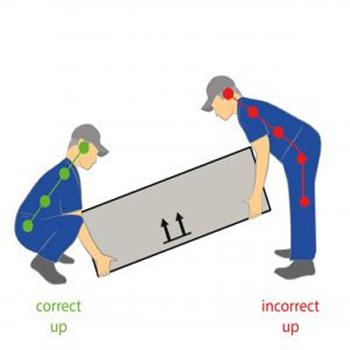Overview of the Level 1 Lift Assessment Evaluation:
Purpose:
- To evaluate an individual’s lifting capacity and biomechanics when handling loads up to 50 lbs.
- To determine fitness for specific job requirements involving manual handling.
Assessment Protocol:
- The evaluation involves a series of standardized lifting tasks designed to mimic real-life lifting scenarios.
- Participants will be asked to lift, carry, and place objects weighing up to 50 lbs, using appropriate techniques.
Key Components of the Evaluation:
- Lift Technique: Assessment of proper lifting techniques, including body mechanics, posture, and use of legs for lifting.
- Strength Assessment: Measurement of muscular strength relevant to lifting tasks, including core stability and grip strength.
- Endurance Evaluation: Tests may include repetitive lifting to gauge muscular endurance and overall physical stamina.
- Flexibility Testing: Evaluation of range of motion and flexibility, which can impact lifting ability and injury risk.
Scoring and Interpretation:
- Performance is scored based on technique, efficiency, and safety during the lifting tasks.
- Results will provide insights into the individual’s ability to safely perform job-related lifting, highlighting areas for improvement.
Benefits of the Evaluation:
- Safety Enhancement: Identifies individuals who may require additional training or assistance to prevent lifting-related injuries.
- Customized Training Plans: Helps in developing tailored strength and conditioning programs based on assessment results.
- Regulatory Compliance: Supports adherence to occupational safety standards and regulations regarding manual handling tasks.
Target Audience:
- Suitable for employees in industries that require manual lifting, including warehouses, construction, healthcare, and more.
- Ideal for pre-employment screenings, fitness assessments, and ongoing employee evaluations.
Important Considerations:
- Participants should wear comfortable clothing and appropriate footwear during the assessment.
- A qualified evaluator should oversee the assessment to ensure proper technique and safety.
The Level 1 Lift Assessment Evaluation is an essential tool for employers seeking to enhance workplace safety and ensure that employees are physically capable of performing lifting tasks. By identifying strengths and potential limitations, organizations can promote a culture of safety and well-being among their workforce.
Why would I need a Level 1 Lift Assessment Evaluation?
The Level 1 Lift Assessment Evaluation is important for:
Job placement and hiring: Employers use this evaluation to determine if candidates or employees have the physical capability to safely perform job tasks that involve lifting up to 50 pounds. It helps ensure that individuals meet the physical requirements for the position.
Injury prevention: The assessment helps identify individuals at risk of injury when lifting or carrying heavy loads, allowing for appropriate training or accommodations to minimize risk.
Return-to-work evaluations: For individuals returning to work after an injury or medical leave, the lift assessment verifies whether they can safely resume lifting tasks.
Workplace safety programs: Companies may include this evaluation as part of their safety programs to monitor employees’ physical abilities and provide ergonomic training, reducing the likelihood of workplace injuries.
How should I prepare for the Level 1 Lift Assessment Evaluation?
Preparation for the evaluation includes:
Wearing appropriate clothing and footwear: Wear comfortable, loose-fitting, closed-toe, non-slip shoes to allow for safe movement and lifting.
Warming up: Perform a light warm-up or stretching routine to prepare your muscles for lifting activities, focusing on the legs, back, and arms.
Hydration and rest: Ensure you are well-hydrated and have had adequate rest before the evaluation, as fatigue or dehydration can affect performance.
Informing the evaluator of any pre-existing injuries: If you have any injuries or medical conditions that may affect your ability to lift, educate the evaluator beforehand so they can modify the assessment as needed or take extra precautions.
Proper preparation helps reduce the risk of injury and ensures you perform your best during the assessment.
